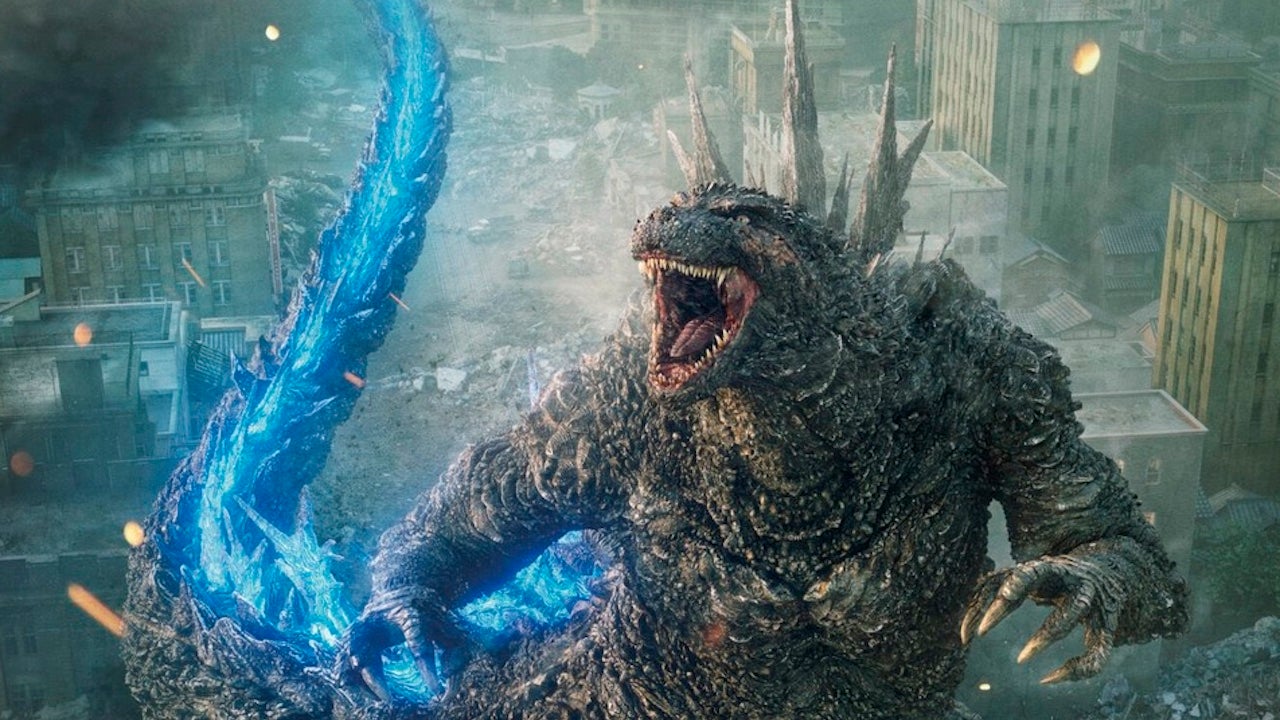
As of this past Saturday, Takashi Yamazaki’s Godzilla Minus One is officially on Netflix in North America, and millions of subscribers are getting the chance to learn why kaiju fans and beyond have been losing their minds about the movie with a giant irritated lizard. Seriously, no less than Steven Spielberg is reported to be a great admirer of Minus One, with the Jaws filmmaker telling Yamazaki he’s watched the film three times.
There is of course a sound basis for this (and not just because Godzilla Minus One in part alludes to Jaws). Not since perhaps the original 1954 Godzilla has the iconic creature appeared so terrifyingly real and so menacingly apt as a metaphor for the industrialized war in the shadow of Hiroshima and Nagasaki. There is indeed a strong case to be made that Godzilla Minus One acts as a perfect companion piece to last year’s Oppenheimer, with the giant monster movie beginning in the aftermath of World War II and a firebombed Tokyo where one would-be kamikaze pilot (Ryunosuke Kamiki) is condemned to survive.
And yet, for nearly half a year, movie lovers and potential Godzilla fans have been denied the chance to see the Big G get truly monstrous again in a film that makes you weep for the ants beneath his feet. And it’s become something of a minor crisis at least on social media and among cinephiles.
“Godzilla Minus One Could Win an Oscar, So Why Can’t Anyone See It?” an IndieWire headline lamented in February ahead of Godzilla Minus One’s big night where it indeed won the Academy Award for Best Visual Effects. “Godzilla Minus One streaming release plan has U.S. audiences scratching their heads as the movie still has no release date stateside,” opined The Direct in March. “When is Godzilla Minus One coming to streaming?” Forbes bluntly asked in April. All of these pieces seemed at least partially in service of a line of thinking among fans, which might be best encapsulated by one exasperated Redditor: “Isn’t this a really long time for a movie to not be available to watch at home in this day and age?” That popular thread was posted less than a month after Minus One completed a two-month run at the U.S. box office.
But therein lies the rub about the long wait for Godzilla Minus One, and why its eventual release on Netflix six months to the day since its U.S. premiere on Dec. 1 is such an anomaly: in this day and age audiences do not expect to wait half a year for a film to be on streaming. Maybe they should.
To be clear, the reasons for Godzilla Minus One’s belated streaming release are likely to be of a trickier, legal origin. While Toho Studios, the mythic film company that’s produced every Japanese Godzilla movie since 1954, has never officially confirmed the reason for the delay, it likely had something to do with a stipulation in Legendary Pictures’ licensing contract for the character. Legendary, along with Warner Bros. Pictures, has been releasing American Godzilla movies since 2014, and there is obvious incentive to not have a Japanese Godzilla film competing theatrically with an American, or “MosnterVerse,” one. The previous contract certainly stipulated that there would be no Toho Godzilla films released in the same year as Legendary’s (which might be one of the reasons we never got a sequel to Shin Godzilla).
While there is evidently more wiggle room in the new contract with Toho that made Godzilla x Kong: The New Empire possible, it’s telling that despite Godzilla Minus One being the most successful Japanese Godzilla film ever at the American box office—with the film grossing $56 million in two months—the movie was swiftly removed from theaters at the end of January despite actually growing its audience in its final weekend due to a new black and white version of the film being offered to movie nerds.
Godzilla Minus One quickly vacated cinemas to make way for Godzilla x Kong a little over a month later, which also got to streaming first by way of premium VOD… but we’d argue this ironically turned out to be in Godzilla Minus One’s favor as first a theatrical and now a streaming event.
In the modern moment of ever-shrinking theatrical windows and the rush to streaming, studios’ desires to short-cut to home media has arguably contributed to the perception of films being disposable and trivial. By rushing to get movies on streaming as fast as possible, studios have encouraged audiences to see them as non-events.
Take last month’s The Fall Guy for example, a semi-original film that’s a real crowdpleaser for the crowds who actually showed up to watch Ryan Gosling and Emily Blunt bring the jokes and stunts. It was marketed as the big kickoff of the summer movie season, but anecdotally plenty of moviegoers saw a film based on an IP they never heard of and assumed they could wait for it to be on streaming soon. It opened below $40 million, so Universal Pictures rewarded the potential audiences who bet on a short wait by putting the movie on PVOD (with a pricy $20 rental paywall) less than three weeks later.
Ironically, The Fall Guy has had small declines week-on-week at the box office even with the film now on streaming. This suggests the word-of-mouth is actually quite good… but not enough to reverse years of studios and audiences conditioning each other to think getting it to streaming, where it can be “second screen content,” is the goal.
Godzilla Minus One, meanwhile, didn’t just have good word-of-mouth. The reception was, instead, spectacular with many critics and outlets putting it among their best films of the year, including our own staff. And as word got out, the film’s U.S. release strategy did an unusual thing for a foreign-language picture: it expanded and legged out for months.
Admittedly, due to its nature of being a foreign language film it was never going to be in as many theaters as a wide Hollywood release—meaning not everyone had the same level of access to see Godzilla Minus One last December or January that they did, say, Aquaman and the Lost Kingdom. Meanwhile others cannot afford to physically or financially make going to the cinema work. So the frustration of waiting four months after Minus One’s theatrical run finished, and six months after it came out stateside, was understandably exacerbated. However, it was always going to come to streaming… eventually.
And now that it has—after a wait comparable to the ones between theatrical and home media releases in the 2000s—Godzilla Minus One isn’t coming to Netflix as just another disposable piece of time-filler you can watch while folding laundry or doom-scrolling on your phone. It’s come to Netflix as a major event; a film that you either loved in theaters or you missed out on and have been wanting to see for months. There’s genuine excitement about a movie being on streaming.
The delay makes the film’s run in theaters and now on Netflix seem exponentially more special than if there’d been a two-month (or two-week) gap. And if more studios would force audiences to wait instead of attempting to salvage a bad opening weekend with a whiplash-induing streaming release, they might actually rekindle some of the moviegoing habits they’ve let evaporate since the pandemic. They certainly would make at least the inevitable streaming release exciting again.
The post Making Fans Wait for Godzilla Minus One on Streaming Was a Great Thing appeared first on Den of Geek.




